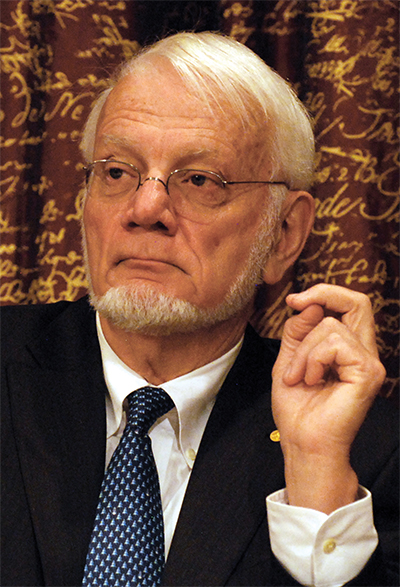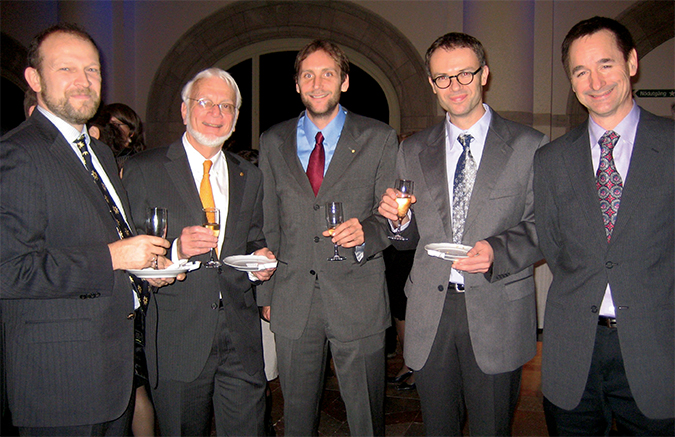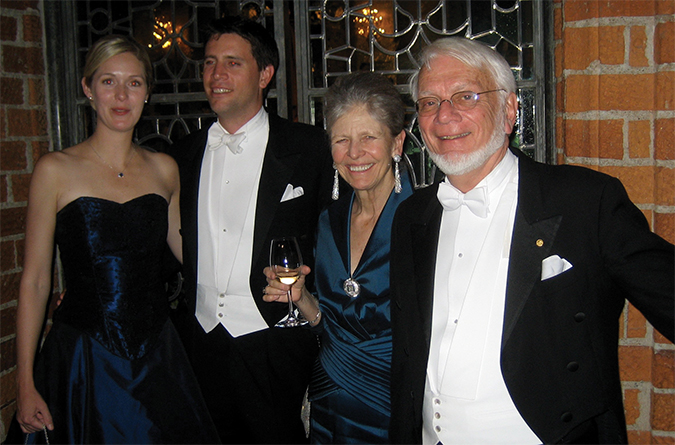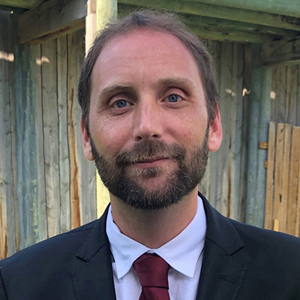Thomas A. Steitz (1940 – 2018)
Thomas Arthur Steitz was a remarkable person, scientist and mentor. He was a Sterling professor of molecular biophysics and biochemistry at Yale University, a Howard Hughes Meafdical Institute investigator, a Nobel laureate and a giant in the field of structural biology. His death on Oct. 9 left a void in the scientific community and for those who knew him as well as a legacy of fundamental discoveries.
Tom was born Aug. 23, 1940, in Milwaukee, Wisconsin. His childhood in a family of five siblings was filled with classic Americana — tennis and skating and summers spent picking vegetables on his grandfather’s farm. In high school, Tom became a skilled saxophonist, developing his lifelong love for music. He also excelled academically, initially spurred on by his younger brother’s higher grades.
 Tom Steitz at the Nobel Prize press conference at the Royal Swedish Academy of Sciences in 2009.PROLINESERVER/WIKIMEDIA COMMONS
Tom Steitz at the Nobel Prize press conference at the Royal Swedish Academy of Sciences in 2009.PROLINESERVER/WIKIMEDIA COMMONS
Tom earned a scholarship to Lawrence College, where he majored in chemistry and credited the humanities courses for maturing his world view. Robert Rosenberg, a mentor at Lawrence, inspired him to pursue a career in science. As a rising senior, Tom attended a conference at the Massachusetts Institute of Technology held by the American Biophysical Society to promote graduate study in biophysics; impressive talks by Alex Rich and Paul Doty had the desired effect. Tom enrolled at Harvard for graduate studies in biophysics in 1962.
Tom intended to study nucleic acids at Harvard until he was wowed by lectures given by Max Perutz, who was visiting from England. Max showed 3D slides of the structure of myoglobin, the first atomic resolution protein crystal structure, an achievement that had won Max a Nobel Prize in 1962. To Tom, seeing was believing: Visualizing a macromolecule was clearly the way to understand its function. This was echoed throughout Tom’s career as generations of graduate students at Yale were asked, “Why don’t you just crystallize it?”
Upon learning that Bill Lipscomb (Nobel laureate for chemistry, 1976) was using crystallography to study proteins, Tom joined his group at Harvard. Working with five postdocs, and most closely with Martha Ludwig, Tom calculated progressively higher electron density maps of bovine carboxypeptidase A, culminating in a 2.0 Å structure of the protein.
At Harvard, Tom met Joan Argetsinger, a fellow Midwesterner and a graduate student in Jim Watson’s lab. Tom and Joan married in 1966, and from then on they were the power couple of molecular biology. Their careers were independent, and they published together only rarely, but it is hard to imagine a more balanced, honored and impactful couple in modern science.
Tom joined David Blow’s lab at the Laboratory of Molecular Biology in Cambridge, England, as a postdoctoral fellow and worked with then-graduate student Richard Henderson (Nobel laureate for chemistry, 2017) on solving structures of chymotrypsin bound to its substrates. These studies led to a mechanistic understanding of the serine protease family and of its substrate recognition. Tom often said the years in Cambridge were his most scientifically fulfilling, and they shaped his view of the optimal scientific environment. He recalled stimulating discourse, always about science, with whichever world-leading scientist (perhaps Fred Sanger, Francis Crick or Sidney Brenner — Nobel laureates all) was sitting next to him in the canteen for lunch. It was a stress-free and wonderful time, he said, with no worries, just exciting science. Asked later about the pressure to produce results to secure a faculty position, Tom replied, “Ah, yes, well. I did have a faculty position waiting for me at Berkeley.”
 Tom Steitz poses with his ribosome trainees in Stockholm after winning the 2009 Nobel Prize in chemistry. Pictured, from left, Poul Nissen, Tom Steitz, Martin Schmeing, Jeff Hansen and Nenad Ban.courtesy of Martin schmeingAs it turns out, he was only at Berkeley for two months. Starting as an assistant professor in 1970, Tom asked the department chair to consider interviewing Joan for a faculty position, as she had also done successful postdoc research in Cambridge. The chair told him promptly that females were best suited to be research assistants and that no female scientist would be considered for a faculty position. (This seems shocking now, when Berkeley is thought of as liberal, but Tom said back then, in general, the students were liberal and the faculty members were conservative, which helped explain why it was a frequent site of protests.) Tom and Joan both received offers at Yale, so they left California for New Haven.
Tom Steitz poses with his ribosome trainees in Stockholm after winning the 2009 Nobel Prize in chemistry. Pictured, from left, Poul Nissen, Tom Steitz, Martin Schmeing, Jeff Hansen and Nenad Ban.courtesy of Martin schmeingAs it turns out, he was only at Berkeley for two months. Starting as an assistant professor in 1970, Tom asked the department chair to consider interviewing Joan for a faculty position, as she had also done successful postdoc research in Cambridge. The chair told him promptly that females were best suited to be research assistants and that no female scientist would be considered for a faculty position. (This seems shocking now, when Berkeley is thought of as liberal, but Tom said back then, in general, the students were liberal and the faculty members were conservative, which helped explain why it was a frequent site of protests.) Tom and Joan both received offers at Yale, so they left California for New Haven.
At Yale, Tom started working on the structure of hexokinase, the first enzyme in the glycolysis pathway, a subject recommended to him by Brian Hartley at Cambridge. Hexokinase structures with and without substrates were Tom’s first big success as an independent researcher. This work with his postdoc Robert Fletterick visualized Dan Koshland’s induced fit model, according to which binding of the cognate substrate to an enzyme caused a conformational change to enable activity. These hexokinase crystals were notoriously robust. In later years, if a trainee was short on crystals for soaking experiments, Tom would recall that when more hexokinase crystals were required, they would simply saw them in half and, “Voila! Twice the crystals.”
Tom had been recruited to Yale by pioneering structural biologist Fred Richards. At about the same time, Don Engelman and Peter Moore were hired, and together with Hal Wyckoff, they formed what became the Yale Center for Structural Biology. By the mid-1990s, this group included Jennifer Doudna, Paul Sigler and Axel Brünger. This concentration of leading structural biologists made for an exciting and dynamic environment that powered each group’s research.
After hexokinase, Tom embarked on a broad research scheme that defined the rest of his career: studies of Crick’s central dogma of molecular biology. Starting in the late 1970s, Tom and his lab made seminal discoveries that provided fundamental understanding about every part of the central dogma.
Most famously, in a collaboration with Yale colleague Peter Moore spearheaded by postdocs Nenad Ban and Poul Nissen, Tom determined the first structures of the large ribosomal subunit. The ribosome structures provided insight into how proteins are made and showed the ribosome to be a ribozyme, making the logical link between the primordial “RNA world” and the modern world dominated by protein enzymes. He also solved structures (with the author) representing each chemical step of the ribosome linking amino acids together, and (with Jeff Hansen) of the ribosome bound by clinically important antibiotics. For this ribosome work, he shared the Nobel Prize in 2009 with Venki Ramakrishnan and Ada Yonath.
 Tom Steitz and his family in Stockholm for Nobel week in early December 2009. Pictured from left, daughter-in-law Katherine, son Jon, wife Joan and Tom.Courtesy of Martin Schmeing Tom trained generations of outstanding students at Yale. He had a reputation for bluntness but was a supportive mentor. He effectively conveyed his excitement for important fundamental science and knowledge for the sake of knowledge. Continuing the advocacy that inspired him to leave Berkeley, he believed that talent and drive, not gender, should be determinants of success and embodied this with egalitarian mentoring. He fostered a rigorous attitude to performing science where the most direct route to a clear answer was prized, a virtue visible in many of his lab alumni.
Tom Steitz and his family in Stockholm for Nobel week in early December 2009. Pictured from left, daughter-in-law Katherine, son Jon, wife Joan and Tom.Courtesy of Martin Schmeing Tom trained generations of outstanding students at Yale. He had a reputation for bluntness but was a supportive mentor. He effectively conveyed his excitement for important fundamental science and knowledge for the sake of knowledge. Continuing the advocacy that inspired him to leave Berkeley, he believed that talent and drive, not gender, should be determinants of success and embodied this with egalitarian mentoring. He fostered a rigorous attitude to performing science where the most direct route to a clear answer was prized, a virtue visible in many of his lab alumni.
All his trainees fondly recall go-to Tomisms such as “if it doesn’t crystallize, add another component to the complex,” “always set up crystal trays before you go on vacation so experiments are still happening while you are skiing” and “if your crystallization drop doesn’t have precipitate in it, you haven’t done the experiment.”
Complementing his no-nonsense attitude to science, Tom had an earnest sense of humor, full of dad jokes and puns, often made with a pause and a telling smile. The antibiotics that blocked peptide movement through the ribosomal tunnel caused “molecular constipation.” The so-called “thumb” domain in polymerases structures that resemble a right hand had to be coloured green in reference to gardening. In his Nobel autobiography, he referred to a spanking as an application of the “board of education” to his “seat of knowledge.” And he would start serious advice in the style of Yogi Berra, “The hardest thing to predict is the future …”
Outside the lab, Tom loved skiing, which led to the annual Steitz-Engelman lab ski trip; the annual “Riboski” trip with RNA-loving colleagues including Tom Cech, Jim Dahlberg, John Abelson and Olke Uhlenbeck; and trips with his son, Jon. Tom was a loving and proud father to Jon, who was born in 1980. Tom and Joan hosted memorable lab picnics and Halloween parties, sometimes serving bottles from Tom’s prized wine collection. He was a keen gardener, at times battling the local Stony Creek rabbits and deer. He also enjoyed hiking in the mountains and sailing among the Thimble Islands.
Tom was at his home overlooking these Thimble Islands when he died from pancreatic cancer. He will be dearly missed.
Some information for this article was sourced from the Thomas A. Steitz Biographical Essay.
The discoveries
These seminal discoveries made in Tom Steitz’s lab provided fundamental understanding of every part of Francis Crick’s central dogma of molecular biology.
DNA to DNA
| • | The first structure of a DNA-binding protein (the catabolite gene activator protein), solved first in the absence and then later in the presence of DNA |
| • | The first structure of a DNA polymerase and structures of many DNA polymerases at mechanistically important states, which together allowed the proposal of the two-metal ion mechanism for phosphoryl transfer reaction, with universal implications for polymerases and ribozymes |
| • | Structures of the homologous recombination enzyme RecA |
| • | Structures of the site-specific recombinase gamma delta resolvase |
DNA to (and from) RNA
| • | A comprehensive series of structures of the RNA polymerase from phage T7, visualizing initiation, elongation and termination of transcription |
| • | The first structure of HIV reverse transcriptase, the key polymerase in the AIDS-causing virus, in complex with a non-nucleotide inhibitor, revealing its mechanism of inhibition |
RNA to protein
| • | The first structure of a tRNA synthetase bound to tRNA, explaining the tRNA recognition that is important for ligating the right amino acid on the right tRNA, and other tRNA synthetase structures illuminating an important proofreading mechanism |
| • | Structures of enzymes required to add the last three nucleotides in a nontemplated fashion onto some tRNAs so they can be used in protein synthesis |
| • | Pioneering ribosome structural biology, including the first structure of the large ribosomal subunit, and co-complexes of the ribosome with substrates, antibiotics and translation factors |
Remembrances
These remembrances were written by scientists who worked with Tom Steitz.
Tom’s loss is felt by all of us who had the honor to train with him. Beyond providing a great environment for learning practical and theoretical crystallography, Tom taught us many valuable scientific lessons: how to keep the big picture in mind, how to set high standards, and how to communicate science effectively. Manuscript figures often went through a dozen iterations — with Tom’s only comment being that they “weren’t quite right yet.” This proved to be pedagogically much more effective than detailed feedback
Additionally, Tom taught us the value of teamwork and collaboration; he often paired a graduate student with a postdoctoral fellow. Together, the two of us were team phi29; the elder of us (ahem) had several other projects as well. We studied how protein-primed polymerases initiate replication. Because phi29 polymerase has extraordinarily high processivity and intrinsic strand displacement capabilities, it is a valuable tool for single-molecule sequencing applications, which one of us still works on today.
The group that Tom established — senior scientists helping junior scientists, extraordinary staff scientists supporting the lab, and the ever-wonderful Peggy — was like a family; we spent so much time together immersed in the science, learning from each other and helping each other grow under the watchful gaze of our fearless leader. We will never forget the phrase, “just because it’s more interesting doesn’t mean it’s more difficult.” His passion for science and crystallography lives on in all of us and his legacy will continue to grow as we continue to train scientists as he trained us.
— Andrea Berman and Satwik Kamtekar
I was a postdoc with Tom Steitz during the late 1980s and early 1990s. It was an exciting time: His research group was expanding rapidly; his vision for bringing structural biology to understand the central dogma was well under way. Research on polymerases, tRNA synthetases, reverse transcriptase, and CAP was in full flow.
It was before the age when everyone has a personal computer, and crystal structures were solved in C10, a basement room in Kline Tower filled with computer terminals and specialized graphics work stations that were shared by members of the WERMS group (Hal Wyckoff, Don Engelman, Fred Richards, Peter Moore and Tom Steitz — joined shortly after my arrival by Paul Sigler). Here, students, postdocs and faculty from the different groups all worked and interacted. It was an intense, immersive experience.
Tom would come down to C10 almost every afternoon and half-teasingly ask whether you had solved your structure yet. For lunch, everyone would decamp to the cafeteria on top of Kline, often to discuss what was going on in science at Yale and elsewhere. It was during one of those lunchtime conversations that I first heard Tom and Peter discuss how to approach solving the structure of the ribosome.
Even while we were still struggling to fit an electron density map, Tom made it very clear that a structure was not the end but the start of understanding. He was a master at transforming these beautiful, complex objects first into molecular mechanism, then into biological understanding, and finally into publications accessible to the community at large. In doing so, he constantly conveyed the excitement of posing interesting questions, discovering new insights, and figuring out how best to tell the world.
Tom also showed that a scientist’s life is lived well through strong social connections. He enjoyed sharing good food and wine (and puns) with others. When entertaining eminent visitors, he often included his students and postdocs. I fondly remember many cookouts at Tom and Joan’s house on the Connecticut shoreline for their two research groups. I do not know whether Tom and Joan ever considered this explicitly, but their life together showed the young scientists who worked with them that the professional scientist’s path can be rich and rewarding. Tom led by example, and working with him was a wonderful experience that I, and others, look back on fondly, having shaped the science that we practice today. He is dearly missed.
— Lorena Beese
I was first exposed to Tom Steitz’s enthusiasm for how structural biology could inform biological mechanisms when I visited Yale as a prospective graduate student in 1986, and he showed us the first structure of a DNA polymerase. It was awesome, as today’s students would say. I never regretted joining his lab, and many aspects of his mentorship still serve me well today: He managed to teach crystallography in a way that was mathematically rigorous but made intuitive sense, he always kept the biological “big picture” in mind, he taught us how to prune distracting detail out of figures, and he never treated female trainees differently than male ones.
He was also a calm and gracious person — one memory that sticks out is of a wonderful beachfront party hosted by Tom and Joan. Some of us land-lubbers decided to take his rowboat out for a spin and managed to lose not one but both oarlocks to the depths of Long Island Sound. After we paddled ignominiously back to shore, Tom took the news with nothing more than a slight lowering of his glasses.
— Phoebe A. Rice
Tom’s untimely passing is a huge loss to all of us whose lives and work were touched by his brilliance and humor. Tom spent his career successfully deciphering the inner workings of the central dogma and thus set the highest standard for all structural biologists. When I joined his lab as a postdoctoral fellow in 1992, Tom and his team had already determined crystal structures of DNA polymerase, reverse transcriptase, tRNA synthetase and several transcription regulators. I was given the project of bacterial gamma-delta resolvase — despite my eagerness to work on the mammalian recombinase RAG1/2, and the fact that the first crystal structure of gamma-delta resolvase had already been determined.
With this assignment, Tom taught me the essential lesson of choosing projects that have interesting biological questions and yet are approachable with currently available tools. He also taught me the lesson of persistence. Even though the first structure of an important biological complex attracts the lion’s share of attention, it often requires several more steps before the mechanism is truly understood. After I had determined the structure of gamma-delta resolvase with DNA bound, which revealed several surprises, Tom walked me through how to give a scientific talk and make one point with each slide — and to use a font large enough for people in the back of the room to see. His lessons on choosing research projects and preparing talks guide me to this day.
In the last 15 years, I had a number of opportunities to spend time with Tom at scientific meetings. He always sat in the front for every presentation, never checking his cell phone or doing anything but listening intently. His scientific presentations were always impeccable. He enjoyed a wry comment and a hearty laugh but was always a stickler for truth. One time, someone wanted an inside scoop on a yet-to-be published structure, and asked Tom what the bending angle of a bound DNA was. Tom hesitated for a hundredth of a second and said, “Larger than 0 and less than 90 degrees.” That person wrote a review predicting a 45-degree bending angle. The actual bend is 60 degrees. We all had a good laugh. I had three perfect days with Tom at a nucleic acid conference at Lake Konstanz last September, and could only wish for more such days.
I miss Tom, think of him often, and will try to solve interesting scientific problems while endeavoring to enjoy life as Tom did.
— Wei Yang
Tom really loved to reference the experiments he had himself performed — those on hexokinase not least. This included ways of making crystals grow thicker, rules of thumb for heavy metal soaks, and how to investigate conformational changes, for example.
I remember when we named the RNA motif where exposed adenosines pack into the minor groove of another RNA helix. I presented a range of suggestions for names; he was not very impressed with any of them, but then was delighted with one of his own: A minor. Music-based puns ensued.
Tom always appreciated the many nationalities and traditions of his lab, and he always enjoyed it when world food was contributed to one of the many social events he would host in Stony Creek. I brought pickled herring and elephant beer on a few occasions. These events were great fun.
— Poul Nissen
Enjoy reading ASBMB Today?
Become a member to receive the print edition monthly and the digital edition weekly.
Learn moreGet the latest from ASBMB Today
Enter your email address, and we’ll send you a weekly email with recent articles, interviews and more.
Latest in People
People highlights or most popular articles

2024 voter guide
Learn about the candidates running for ASBMB Council, Nominating Committee, Publications Committee and treasurer.

Charles O. Rock (1949 – 2023)
Colleagues and trainees remember a world expert in membrane lipid homeostasis.

Honors for Clemons, Hatzios and Wiemer
Awards, honors, milestones and more. Find out what's happening in the lives of ASBMB members.

Touching the future from the bench
Scholar, scientist, teacher and mentor Odutayo Odunuga discusses the important roles of the institutional PI, his journey and his research.

In memoriam: Darwin Prockop
He held leadership positions at multiple institutions and was known for his contributions to adult stem cell biology and cellular biology.

A look into medical writing
Our careers columnist spoke with Ashlea A. Morgan at Chameleon Communications International to get a sense of one type of work a medical writer can do.


